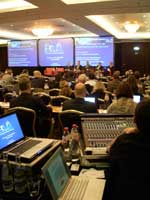 |
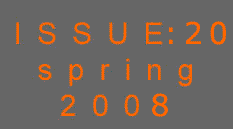 |
Issue No. 20 Spring
|
|
ENS News |
|
ENS Events |
|
Member Societies & Corporate Members |
|
Taming the Chernobyl Avalanche IAEA presents results of OSART Mission The Advanced Reactor Group (GRA) Calculation of the neutron flux, fuel and moderator temperature transients for Research Reactors |
YGN Report |
|
European Institutions |
|
ENS World News |
ENS Members |
| Links to ENS Member
Societies Links to ENS Corporate Members Editorial staff ______________________ |
| _____________________ |
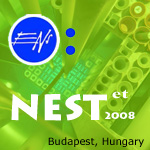 |
____________________ |
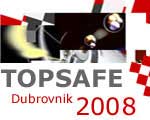 |
____________________ |
|
|
|
On 15 and 16 April around 180 people congregated at the Marriott Hotel in Brussels to take part in ENA 2008 (the European Nuclear Assembly). This biannual international conference organised by FORATOM is the largest event of its kind on the European |
 |
events calendar. The title of this year’s ENA was Nuclear Energy: Developing Europe’s Low-carbon economy, which reflected one of the EU’s main policy priorities, namely to encourage sustainable economic growth while at the same time reducing the Community’s carbon footprint. Among the participants were senior EU officials, MEPs, leaders of industry, representatives of think tanks and consumer groups and several ENS members. The accent was on broad stakeholder involvement in the debates.
ENA 2008 kicked off under the chairmanship of Bruno Lescoeur, Senior Executive Vice President of EDF, with an opening session entitled Low-carbon energy policy in Europe. The first guest speaker was EU Energy Commissioner, Andris Pieblags, who gave an overview of EU energy policy in general and the importance of the nuclear component in that policy. He spoke about the latest policy developments in the nuclear field, including the European Nuclear Energy Forum (ENEF) and the Sustainable Nuclear Energy Technology Platform (SNETP), stressing the important role that nuclear energy has to play in the EU’s future energy mix and the need to guarantee safety and security safeguards when it comes to operating plants and handling radioactive waste. One of the strongest messages to emerge from his presentation was the need to extend the lifetime of existing nuclear power plants and build the next generation of reactors that will continue to underscore nuclear energy’s important contribution to the goal of achieving a low-carbon economy. For the Commissioner to have given such an endorsement of the role of nuclear energy in the EU’s energy future would have seemed inconceivable only a couple of years ago, when discussions about the role of nuclear energy were largely marginalised to the fringes of the political debate.
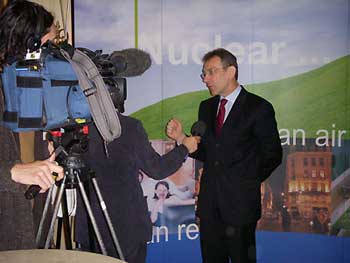
Pierre Sellal, France’s Ambassador to the EU then addressed the Assembly on the priorities and challenges facing the forthcoming French Presidency and its future promotion of nuclear energy as a vital component of the Community’s low-carbon economy.
Czech MEP Miroslav Ouzky (EPP-ED), who is also the Chairman of the European parliament’s Environment Committee, spoke to the conference via a recorded video link. He emphasised how the debate in favour of nuclear energy as a main pillar of the fight against climate change has gained considerably in impetus in the European Parliament of late (e.g. with the recent adoption by an overwhelming majority of MEPs of the Reul Report on Conventional Energy Sources and Energy Technology, which contained a ringing endorsement of nuclear energy as “the largest low-carbon energy source in Europe”). Mr Ouzky added that without nuclear energy the EU would never reduce its carbon footprint as renewable energies alone could never achieve this goal.
|
With the nuclear revival well under way in several European countries and ambitious new build programmes in the pipeline, another main subject of debate at ENA 2008 was the question of supporting the current drive for new build that is gathering momentum across Europe and beyond. Two keynote speakers spoke on the subject: first up was Gérard Mestrallet, CEO of Suez, who emphasised how the building of a new power plant should be viewed as part of a long-term commitment: “A nuclear project covers a |
period of almost a century – it takes10 years to build a plant, the plants operates for 60 years and the decommissioning phase takes 20 years.”
Christian Waerterloos, Director of Nuclear Energy at the European Commission’s DG TREN, thengave a wide-ranging presentation about the current state of nuclear policy in Europe, and in particular on the EU’s drive for new build and its promotion of the lifetime extension of existing NPPs as an “intermediary measure.” The session was followed by a panel debate that featured short statements from Gerd Jäger, Executive Vice President of RWE Power, Germany; Sandor Liive, CEO of Eesti Energia (Estonia); Philippe Rosier, President of Rhodia Energy Services and Chairman of BUSINESSEUROPE Energy Group and Bruno Lescoeur.
Next on the ENA 2008 agenda was a session devoted to an EU policy debate on safety and waste management. After a keynote address by Christian Waeterloos, the panel debate was launched by presentations from a regulator’s, operator’s and international organisation’s perspective. Bernard Fourest, who is a member of the Steering Committee of ENISS (European Nuclear Installations Safety Standards), outlined the work being done by European regulators to standardise safety standards at Europe’s nuclear plants and ENISS’ input to the work of WENRA (Western European Nuclear Regulators’ Association). Hans Forsström, Director of the IAEA’s Division of Nuclear Fuel Cycle and Waste Technology, then gave a view of global developments in the field of waste management. Finally, Hans Codée of the Dutch national centre for radioactive waste management, COVRA, emphasised how the technology needed to safely store radioactive waste of all levels exists in Europe and that the problems and dangers generally associated with waste can be easily overcome. He also said that the public can be convinced of the safety and efficiency of waste storage if the success of operations like those at COVRA is communicated effectively.
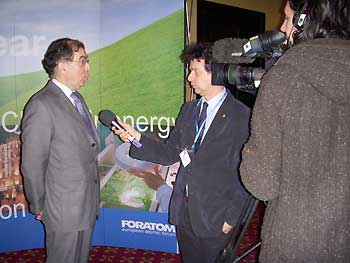
The final session on Day 1 of the conference had a sharp technical focus with a series of presentations and a subsequent debate on the very latest in nuclear reactor designs entitled: The appliance of science: designing the reactors of tomorrow. The panel members that started the debate rolling were Didier Haas, of the European Commission’s Joint Research Centre (JRC); Franck Carré of the CEA, who is Co-ordinator of the SNETP’s Working Group on GEN IV Reactors and François Hédin, Chairman of European Utility Requirements (EUR).
Later that evening a Gala Dinner at the Brussels Bourse featured a speech from Hungarian MEP Edit Herczog (PSE) in which she noted the great recent strides that have taken place within the Parliament with regards to the nuclear debate. She congratulated the efforts of MEPs and industry alike to promote the nuclear cause.
Next morning delegates returned bright and early to take part in Day 2 of the conference. Proceedings began with a session about the financing of nuclear new build called: Creating the optimal conditions for financing nuclear investments. Various financing models were discussed and delegates were able to judge which model was best suited to the business model and financing culture prevalent in their respective countries. The keynote speaker for this session was Lauri Piekkari, Vice President and Treasurer of TVO, who presented the successful financing model behind the Olkiluoto 3 construction project and later joined the panel for the debate.
Presentations were made by two 2 panellists: Gabriel Burlacu, President of the Board of Nuclearelectrica (Romania) spoke about how Cernavoda 2 was financed and units 2 and 3 (currently under construction) are being financed. Patrice Lambert de Diesbach, Head of Research at CM-CIC Securities spoke about EDF’s financing model and emphasised how nuclear energy, compared to other major energy sources, is competitive when it comes to financing costs, CO2 avoidance costs and consumer electricity prices (France has the lowest household electricity costs in Europe after Austria).
The next session, entitled Reconciling economic growth and the low-carbon economy, highlighted the main conference theme. Arne Mogren, Head of Climate Policy at Vattenfall, Sweden, underlined what all industrial sectors must do in order to reduce global temperatures by 2°C by 2030. He also spoke about the cost and opportunities of various CO2 abatement measures, including carbon capture and sequestration (CCS). Hans Grünfeld, President of the International Federation of Industrial Energy Consumers (IFIEC) gave a consumer’s perspective of how reconciling economic growth and the low-carbon economy impacts upon prices.
Malcolm Grimston, Associate Fellow in Energy, Environment and Development at the British think-tank Chatham House, gave a bleak overview of spiralling global energy demands and stressed the urgent need for new technology, nuclear power and changes in lifestyle to lead the drive to reduce CO2 emissions. He underlined how nuclear energy is an attractive option when it comes to reducing CO2 emissions and how the cost of carbon abatement is low in comparison with carbon capture and storage and most renewables. Gordon Adam XXXXXX
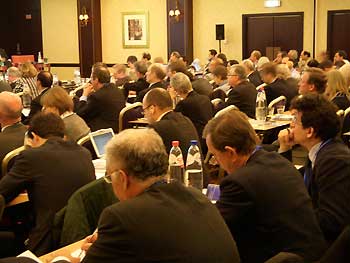
The final session at ENA 2008 was entitled: The future of nuclear energy: investing in skills and talents. Slovenian MEP Romana Jordan-Cizelj (EPP-ED) kicked it off with a keynote address on the urgent need for governments and academia to do more to identify, recruit and retain the most talented young scientists and researchers -because it is they who will sustain the nuclear revival. The subsequent debate focused on a number of initiatives launched by the nuclear industry to redress the “nuclear talent deficit” and of the gradual improvement of the situation in a number of countries. Christophe Alois Heil, Director of Nuclear Affairs at EnBW (Germany), spoke about the programme of training and educational courses that the German operator offers to young people seeking a career in the industry. Jean Llewellyn, Chief Executive of the National Skills Academy for the Nuclear (NSAN) Industry then presented the work that her recently-formed organisation is doing in the UK to encourage the learning of new skills, the retraining of the existing workforce, the need for flexibility and mobility in the workforce and the partnership between universities and NSAN to achieve an offer more attractive courses for students of science, technology, engineering and maths – including at school level. The last panel speaker was Edouard Hourcade, Vice Chairman of ENS’ Young Generation Network. He spoke about what the industry should do to attract more young people to pursue a career in nuclear engineering and research. He stressed the importance of skills building and innovation as ways of attracting young people and of the need for knowledge transfer from the “older” generation to the younger generation. He summed up the needs of the research sector by saying that “R & D is like building a cathedral, it requires faith.” With the future of nuclear energy an ever-present focus during the conference, it was quite appropriate that the last word went to the Young Generation Network.
Judging from the positive comments received by delegates, ENA 2008 was a great success. It also attracted a record number of journalists and subsequent media coverage was greater than for any previous Assembly. Many sessions were of direct interest to the nuclear science community and the policy debates showed how the continued fight to achieve economic growth while promoting a low-carbon economy requires a vital input from the science and research community.
For more information about ENA 2008 visit the FORATOM website
at the following address: www.ENA2008.org
| |

